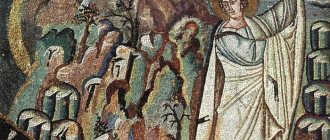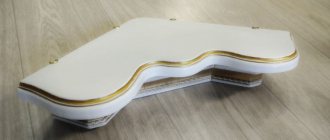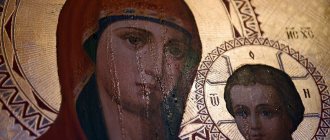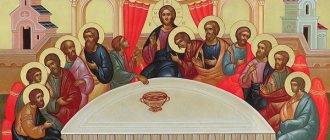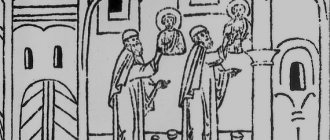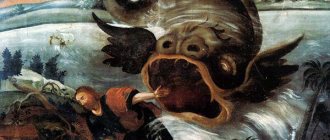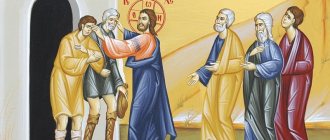Nikita Tomin, Ilya Butov, Vadim Aleksinsky, Alexander Moskovsky, Pavel Florensky, Mikhail Debely “Nature” No. 10, 2019
About the authors
| Nikita Viktorovich Tomin — Candidate of Technical Sciences, senior researcher at the Institute of Energy Systems named after L. A. Melentyev SB RAS. Area of scientific interests: electrical power engineering, artificial intelligence, religious phenomena. |
| Ilya Stanislavovich Butov — Candidate of Agricultural Sciences, researcher at the All-Russian Research Institute of Vegetable Growing, a branch of the Federal Scientific Center for Vegetable Growing. Specialist in hybridization, selection, sacred geography. |
| Vadim Sergeevich Aleksinsky - applicant, doctor at the specialized clinic Neukirchen. Scientific interests: pathological anatomy, immunohistochemistry, cancer diagnosis, histopathology. |
| Alexander Viktorovich Moskovsky — Candidate of Physical and Mathematical Sciences, researcher at the Russian Orthodox University of St. John the Theologian. Area of scientific interests: religious studies, religious phenomena, history of Orthodoxy. |
| Pavel Vasilievich Florensky - Doctor of Geological and Mineralogical Sciences, Professor of the Russian State University of Oil and Gas named after I.M. Gubkin. Scientific interests: oil and gas geology, meteorology, ethnology, history of Russian philosophy. |
| Mikhail Alexandrovich Debely - Candidate of Biological Sciences, researcher at the University of Friborg. Specialist in the field of biochemistry, lipidomics, mass spectrometry. |
Myrrh-streaming in general refers to the appearance of any moisture on the surface of icons or objects of worship. It can occur not only within the walls of sacred buildings (monasteries, temples, cathedrals), but also in ordinary residential buildings or apartments [1–4]. Various, most often natural, processes are taken for myrrh streaming (the release of resins or shellac, the swelling and decay of glue and some organic substances used in painting, the deposition of condensation or fogging, the sorption of various substances on lipophilic surfaces, the formation of rust). In addition, this may be the result of the vital activity of specific bacteria or other microorganisms, traces of oil, oil from lamps, etc. [].
As a result of myrrh flow, precipitation of liquids of different chemical compositions quite often occurs on the surface of icons (Fig. 1). If the icon is glazed, an oily liquid appears on the outer surface of the glass, but it is not uncommon for it to appear under the glass. Traces of oil of various shapes (most often irregular) were repeatedly observed next to the icon, and sometimes a decrease in the frequency and size of the drops was recorded as they moved away from the icon. Oil deposition around icons occurs less frequently, in which case it is more correct to speak not of myrrh-streaming, but of oil deposition. Myrrh collected from icons has a varied consistency and color, often resembling an oily liquid similar to resin []. In some cases, such a liquid has a pleasant odor, reminiscent of the smells of aromatic substances (in particular, roses, jasmine, lavender, etc.) that are part of perfumes or incense [, ]. Sometimes the discharge, which has the consistency of oil, is called oil. However, in a broad sense, oil is olive oil, and later in Orthodox church use any consecrated vegetable oil [].
Rice. 1.
Myrrh-streaming icon of Panteleimon the Healer from Klin
Until recently, the substance from myrrh-streaming objects was not the subject of objective scientific analysis, primarily due to the popular belief that it is always falsification. We do not deny that this is often true, since we have encountered deception for selfish purposes. However, many cases of the appearance of a “peace” on icons, independent of the environment, have been recorded. Moreover, many experienced priests, observing the appearance of oil and the excitement occurring among the parishioners, take such an icon to the altar, not seeing anything special in it.
We believe that along with falsification or careless care of the icon, completely natural processes can also occur. They became the subject of our attention. Therefore, it is permissible to study “miraculous phenomena” using scientific methods, which should be monitored, tested and repeated by studies in various laboratories using several alternative approaches. The study of “miracles” associated with the substance of icons began almost a quarter of a century ago, when an expert working group was created to describe miraculous signs in the Russian Orthodox Church (ROC) under the Synodal Theological Commission of the Moscow Patriarchate (hereinafter referred to as the expert group).
In this article, we tried to demonstrate the possibility and feasibility of using modern scientific methods to study samples of liquids appearing on the surfaces of icons and other religious objects. The presented material is divided into two main parts. The first provides an analytical review of the few scientific studies in this area. The second is devoted to the results of the analysis of samples obtained from icons of the Iveron Mother of God from the city of Klin, Moscow region. and village Elbow, Bryansk region. The methods used were high-performance gas chromatography of esterified fatty acids coupled with mass spectroscopy; lipidomics with direct injection into the mass spectrometer, as well as bacterio- and mycological analyses.
What does the term “holy ointment” mean?
The term “myrrh-streaming” is based on the word “myrrh”, which is literally translated from ancient Greek as “oil with aroma”. Orthodox Christians consecrate new churches with its help, and also use it during the sacrament of confirmation. The making of myrrh itself is a sacred ritual that dates back to the time of the twelve apostles.
According to the canons of the Russian Orthodox Church, before starting to create aromatic oil, it is necessary to obtain the blessing of the patriarch. The manufacturing process occurs very rarely (once every few years), accompanied by solemn chanting and offering many prayers to God. Immediately after the production of the holy myrrh is completed, the odorous liquid is poured into containers, securely sealed, and then distributed to church districts.
“Miro” is translated from ancient Greek as “oil with aroma”
Icons that stream myrrh release precisely this oily substance. It can be of different colors and consistency. When they say that “the faces are crying blood,” they do not mean it specifically. The red tint appears due to the admixture of paints with the corresponding pigment that were used to paint the images. Sometimes the myrrh appears a little, but it happens that the shrine is directly “washed” with it.
Theologians say that the fact of myrrh-streaming does not mean that even the icon of the Mother of God is miraculous
The Orthodox Church believes that all canonical icons, regardless of whether they are in a church or at home, are sacred due to their spiritual content and meaning.
Moreover, some of them are chosen by God's Providence for special signs. They show the world material signs of the appearance of the heavenly world, the Kingdom of God - fragrance, indescribable light, myrrh.
Reliquary with the relics of St. Demetrius of Thessaloniki, Thessaloniki. When the Muslim Turks captured Salonki, they collected myrrh from his relics, considering it a cure for all diseases
In the “Complete Church Slavonic Dictionary” by G. Dyachenko it is said that the epithet myrrh-streaming means: “exuding miraculous myrrh for the healing of diseases.” At the same time, myrrh-streaming icons are not always able to create a miracle of healing.
The myrrh exuded by such an icon or relics is in any case recognized as miraculous. In the history of the Orthodox Church, there are cases when even Muslims collected myrrh, who considered it a medical drug for any disease. This happened during the Turkish capture of the city of Thessaloniki, where the relics of St. Demetrius of Thessalonica were kept.
There are known cases when Muslims collected myrrh from Christian icons and relics of saints.
The church community also reacts ambiguously to “crying” icons. Thus, a member of the commission for the description of miraculous signs in the Russian Orthodox Church, Pavel Vasilyevich Florensky, says that “the icons recognized and revered in Rus' have never streamed myrrh.
Only new icons and those that stand in private homes “cry.” At the same time, he also calls on believers not to focus on the fact of myrrh streaming, since any canonical icon is already recognized as sacred by virtue of this fact.
Metropolitan Nikolai of Nizhny Novgorod and Arzam. Metropolitan Nikolai is wary of treating with caution the facts of the myrrh-streaming of icons after 68 icons were immediately myrrh-streamed in his diocese
Modern theologians also call for a sober approach to the facts of the expiration of the ointment. So Andrey Kuraev says:
Andrey Kuraev
Theologian
“... in itself, blood, tears, and myrrh streaming is not an argument for the holiness of a particular image, especially a character.” Metropolitan Nikolai of Nizhny Novgorod and Arzamas said the following about this: “Nothing is myrrh-streaming for me. ... We have a parish in the Bogorodsky district. Suddenly there was a huge uproar: 68 icons had lost their myrrh! I grabbed my head. ... A commission was quickly created. All icons have been wiped clean. The temple was sealed and closed. It stood for a week. At least one drop appeared. So I approach this with a certain wariness.”
Why does the icon stream myrrh?
The miracle of myrrh flow was mentioned in the Gospel. According to Holy Scripture, aromatic oil was released on the remains of the Apostle Philip, John the Theologian and Fedot. It has not yet been possible to identify a pattern why this or that shrine “cries”. Eyewitnesses talk about the appearance of myrrh not only on ancient church images, but also on household icons. No one can yet explain this phenomenon, but Christians know for sure that this is a sign that the Almighty sends them.
Some associate it with good news, others see it as a warning of future misfortunes.
Christian faith is not based on a miracle, but is based on faith
If we sum it up, we can say that the Orthodox Church is wary of the facts of icons streaming myrrh and other miracles.
The fact is that Myrrh Streaming is not one of those miracles that demons cannot repeat in order to deceive, if possible, even the elect (Matthew 24:24). For example, in India, some pagan stone idols not only exuded milk, but also drank it. There are even recorded cases of Buddha statues streaming myrrh.
"The Temptation of Christ" (mosaic of St. Mark's Cathedral). The devil tempted Christ in the desert, inviting him to perform a miracle so that people would believe him. Therefore, an Orthodox Christian should treat all miracles with reasonable distrust.
The Fathers of the Church teach that our Faith should not be based on miracles, since neither the Holy Scriptures nor the Holy Fathers are commanded to seek miracles. In addition, the craving for miracles is clearly condemned in spiritual literature.
The Gospel says this about this: “An evil and adulterous generation seeks a sign” (Matthew 16:4). Moreover, in the book of the Acts of the Apostles, Simon the Magus surprised many people with miracles, who recognized the power of Satan acting in him as the great power of God (Acts 8:10).
(Matt. 24, 24)
Holy Scripture says that the flow of myrrh is a miracle that demons can perform.
Saint Ignatius Brianchaninov wrote the book “On Wonders and Signs.” In it he warns against being carried away by miracles. The point is that they can replace faith. As a result, a person will be deceived and fall into the sin of shallow wisdom. He will stop confessing, repenting and receiving communion, which will lead him to spiritual death, that is, interrupt his connection with God.
Ignatius Brianchaninov “A Word about Man. About signs and wonders." Saint Ignatius wrote a book outlining the Orthodox view of miracles, including the streaming of myrrh in icons
The Church teaches that accepting false miracles as true damages the soul. That is why there is a recommendation for Orthodox Christians “neither reject nor accept.” This means that if we accept a false miracle, we can fall into deception, and if we immediately reject a true miracle, we can fall into unbelief or blaspheme the Providence of God.
That is why a distrustful attitude towards phenomena from the spiritual world is a sign of the spiritual health of the believing soul of an Orthodox person. Thus, the unhealthy passion of some believers for miracles, in particular for the flow of myrrh, indicates a weakening, not strengthening of faith.
The Orthodox Faith is based on the greatest miracle - the Miracle of the Resurrection of Christ.
By leaving a comment, you accept the user agreement
Video “Why do icons stream myrrh?”
This video presents the opinion of one of the archpriests.
Church ministers' point of view
Theologians who study myrrh-streaming images cannot give a concrete answer as to why this phenomenon occurs. In their opinion, the Almighty chooses a certain shrine through which he sends a special Divine Sign to people. The clergy believe that the fragrance emanating from the oily substance is also a symbol of the manifestation of the Will of the Lord. It, like oil, has healing properties.
The meaning of releasing chrism is often not immediately clear to clergy. However, by the nature of the myrrh flow one can judge future events. Thus, the liquid flowing from the eyes of the icon indicates imminent misfortune. Oily drops mean a good omen. But “tears of blood” promise difficult trials.
Despite the healing properties of the aromatic oil, the shrines themselves are rarely recognized as miraculous.
Oily drops mean a good omen
Skeptics' opinions
Skeptical people refute Divine intervention and try to find a logical explanation for the miraculous phenomenon. In their opinion, the substance released by the shrines is not myrrh at all, but condensation or tree resin. There is some truth in the words of skeptics, because history knows many cases of falsification. However, fragrant oil does not appear only on the original icons. There is a lot of evidence of paper copies, metal faces, mosaics, frescoes or lithographs being myrrh-streamed.
Scientific explanation
Scientists have also not yet found a clear explanation why the shrines “cry”. In their studies, they more than once considered the hypothesis given above. However, after a series of analyzes it was proven that the flow of myrrh is not related to the chemical composition of the wood on which the holy face is depicted. Also, researchers have not found a relationship between the saints painted on the canvases, the age of the icons, their location, or the material from which they are made.
Myrrh-streaming also does not always obey physical laws. It happened that myrrh flowed from bottom to top or flowed towards the center from the sides of the shrine. The only thing that has found scientific confirmation is the composition of the liquid. Despite the different color, consistency or oiliness, the substance is completely organic and similar to a human tear. A detailed analysis showed a large amount of protein that only a living creature can produce.
Myrrh-streaming of icons from the point of view of science
There are various scientific attempts to explain the myrrh flow of icons. For example, oil may end up on an icon as a result of natural condensation of oil vapor from nearby lamps. Often in such cases, the appearance of liquid is also observed on foreign objects.
According to another version, oil may appear on the icon due to the capillary effect. That is, the movement of tree resin through the pores of the wood from which the icon is made. Also, oil is often applied to the icon by contact, as a result of the touch of parishioners after anointing.
Myrrh-streaming of past centuries
The mystery of “crying” shrines has occupied the minds of Orthodox Christians since the early Christian period. As already mentioned, the flow of myrrh was described in Holy Scripture. It was also mentioned in the apocrypha, unrecognized by the church.
The miracle was first reported by the Byzantine chronicler John Skylitzes, who dates the miraculous phenomenon to 1040. After Epiphany, Rus' also learned about myrrh-streaming icons. One of the records comes from the pen of Dmitry Rostov, a bishop of the Russian Orthodox Church, which confirms that “crying” images were already encountered in the 7th century.
The miracle was first reported by the Byzantine chronicler John Skylitzes
The secret of exposure
On the one hand, such a sign always carries a bit of uncertainty: no one knows what this phenomenon portends - good or evil, and what one should prepare for. On the other hand, even deeply religious people sometimes doubt the authenticity of such a phenomenon. This is because history knows many cases when clergymen tried to deceive the people and the authorities in this way in order to achieve certain goals.
Thus, under Peter I, the clergy of one of the churches stated that in their cathedral a phenomenon of myrrh-streaming of icons occurred. The revelation was not long in coming. Despite the fact that the king was a believer, he still doubted the authenticity of what was happening. The priests unanimously declared that in this way God mourns the old order, which was abolished by the Great Tsar. Peter I dared to assume that, using this event, the priests wanted to persuade him to cancel the innovations and return to the old order.
He was quite skeptical about such a “divine” manifestation and ordered the myrrh-streaming image to be taken away from the cathedral. After arriving at his palace, the king destroyed the icon and discovered capsules with liquid located inside it in the eye area. In turn, small holes were made in the eyes through which the liquid came out.
In this regard, the tsar issued a formidable decree, which read: “If the icons in any church cry, then the priest’s asses will cry with blood . Since then, the images no longer “cryed.”
Myrrh-streamings of recent decades
Until the twentieth century, cases of myrrh streaming from shrines were rare. However, by the end of the 90s, many reports appeared that the Sovereign Icons of the Mother of God “cryed” en masse. The first person to cast myrrh was in the cathedral of the Nikolo-Perervinsky Monastery. Then the news came from the Assumption Church, where drops of myrrh appeared on the face of the Kazan Mother of God.
When a miracle happened to the icon of Tikhon of Zadonsk in 2004, the world learned about the plane crash of the TU-154 passenger airliner, which claimed the lives of hundreds of people. The sign also descended before the Beslan terrorist attack and military confrontations in the Donbass.
However, not only Russia is rich in miracles. Thus, the Iveron image of the Mother of God, which adorns the Montreal Cathedral, continuously streamed myrrh for 15 years. And the year 2009 was remembered for the “tears of blood” with which the icon “Softening Evil Hearts” “cryed” during a service in the Sevastopol Church.
Modern myrrh-streaming icons
The myrrh-streaming of the Mother of God “Tenderness” icon began in the 90s and continues in our time. The paper image began to exude myrrh in the house of one of the residents of the village of Lokot, Bryansk region. Later, images of the Savior Not Made by Hands and the Mother of God appeared on the reverse side of the icon. The shrine was decorated with a chasuble and placed in an icon case. Today the icon belongs to one of the dioceses of the Kursk region and is an object of pilgrimage.
In 2015, the Kazan Icon of the Mother of God in the Valaam Monastery began to exude myrrh. The miracle occurred at the All-Night Vigil on the eve of the patronal feast of the monastery where the icon is located. In 2016, the Kazan Icon of the Mother of God was consecrated in the Moscow Church of the Beheading of John the Baptist near Bor. According to Metropolitan Hilarion (Alfeev), the miracle was repeated a year later. This happened when the relics of St. Nicholas the Wonderworker were brought to the capital. In 2018 and 2021, this icon exuded myrrh on the feasts of the Mother of God.
In 2021, on the eve of the feast of the Epiphany, the icon “The Savior Not Made by Hands” was myrrhized in the Church of the Three Saints in the Kazakh city of Karatau. The image first began to exude myrrh back in 2000, on the eve of Easter. In 2021, it was reported about the myrrh-streaming of the Mother of God icon “The Sign” in the Archangel Michael Church in the Tula region.
What icons are now streaming myrrh in Russia?
Orthodox believers honor myrrh-streaming images as miraculous, although not all of them are. Parishioners strive to venerate the shrines, praying for healing or other help. Since the day of the baptism of Rus', history has known more than a thousand “crying” icons, most of which are the faces of the Blessed Virgin Mary. Most of the shrines are located in Moscow:
- passion-bearer Tsar Nicholas II (St. Nicholas Church, Pyzhi);
- St. Nicholas (ibid.);
- Our Lady of Kazan (Cathedral of the Life-Giving Trinity, Bersenevskaya Embankment);
- Iveron Mother of God (Church of the Archangel Michael, Maiden Field);
- All Saints (ibid);
- Mother of God “Seven Arrows” (ibid.).
Icon of Our Lady of Kazan
Mother of God "Seven Arrows"
Passion-bearer of Tsar Nicholas II
Church opinion
The clergy have ambivalent attitudes towards the flow of myrrh. According to Christian doctrine, icons are associated with the prototypes imprinted on them. The spiritual message embedded in the prayer passes through the icons to the patron saint, the Mother of God or the Savior. Myrrh streaming is a message from the other side, a sign of the Kingdom of God. But what exactly the drops of oil on the face portend is difficult to guess.
Cases of icons streaming with myrrh are investigated by a commission from the diocese to rule out fraud. Chemical analysis revealed that the composition of the world from the icons contained sunflower oil, as well as a substance from the resin of deciduous trees growing in Arabia. The clergy do not allow more thorough scientific research of the shrines. Laboratory tests will not help to understand where myrrh comes from. A technique for measuring miracles has not yet been invented.
The facts of falsification are recognized in the church environment. The priests resort to a ruse to attract believers to the temple and collect large donations. Participants in commissions investigating cases of myrrh streaming noticed a pattern: only icons of private owners and new images cry. The chief expert of the group for the study of miracles of the Russian Orthodox Church, P. Florensky, expressed a philosophical interpretation of the phenomenon: one should not exaggerate the importance of myrrh flow. The real or staged phenomenon is performed for the glory of God. Professor Florensky also notes that the famous ancient Russian shrines did not stream myrrh.
According to modern theologians, the appearance of tearful, bloody, oily liquid does not mean the unconditional holiness of the object. Pagan idols were covered with oil. The icons of the “Virgin Center”, a new Moscow sect, are actively shedding tears. The phenomenon is often used for personal gain. Each case must be verified so as not to mislead believers.
In most cases, myrrh streaming is declared a miracle. But the evil one can disguise himself as divine miracles and awaken vanity in priests and owners of unusual images.
What to do if the icon of the house is streaming myrrh
Images can “cry” not only in churches. Myrrh-streaming often occurs at home. No one can answer why this happens. The clergy attribute this miracle to the Almighty, who thus sends a message or warning to the person.
You should not be afraid if your home icon has become myrrhized, because in most cases this is a good omen.
Helpful information
If the image “cries,” there is no need to wipe the myrrh off it. You should treat such a phenomenon with honor, since the Lord chose you to become a witness to this miracle. Pray before the holy face, offer praise, ask for help. However, do it respectfully, sincerely, with your thoughts away from everything worldly.
The myrrh streaming of icons is a phenomenon that has not yet been fully studied. Researchers of antiquities, clergy and scientists are working together to unravel this miracle. For now, one thing can be said: the appearance of holy oil in images is a sign of God, designed to warn of future events.
If you find an error, please select a piece of text and press Ctrl+Enter.
The Russian Orthodox Church checks “crying” icons according to its own procedure
Icons in Russia cry quite often and in many cases the facts of myrrh-streaming are questionable, which is why the Russian Orthodox Church has developed a special procedure for commission examination of myrrh-streaming.
According to it, after discovering the fact of the expiration of myrrh on the icon, this is immediately reported to the diocesan administration. It sends a special commission to the temple to find out what this means. If the icon is at the home of a private person, then the commission can visit his home, with the consent of such a person.
Examination of the myrrh-streaming icon of the Kazan Mother of God in the Valaam Monastery
The commission’s tasks include examining the icon to establish its location and storage conditions, and interviewing witnesses. In addition, its members can also take a photo of the icon. In the event that the first commission has made a positive conclusion, a second commission is sent to the site.
Its task is to more thoroughly investigate the possibility of oil stains appearing on the image naturally.
The fact of unnatural myrrh-streaming of icons will be checked by a special commission of the diocesan administration.
If the second commission also does not reveal the natural origin of the myrrh, the icon is placed in a sealed icon case. In the case where oil stains are detected here too, the icon is declared myrrhic.
“Moscow Diocesan Gazette” for 2005 published an article devoted to the study of the facts of the mass myrrh-streaming of icons that took place in Klin in the house of V.M. Zhuchkova. Analyzing them, members of the diocesan commission established the following:
- all the icons streamed myrrh in different places and were not associated with one “intended” or “holy” place;
- genuine myrrh-streaming was never associated with the presence of a specific living person next to him;
- genuine myrrh-streaming always continued if the icon was brought to the temple.
“Myrrh-streaming” icons by V.M.
Zhuchkova in her apartment. 2003 The Russian Orthodox Church did not recognize the fact of their myrrh-streaming. Thus, using the example of V.M. Zhuchkova can say that cases of mass myrrh streaming of icons and their photographs are of a non-ecclesiastical nature. They do not correspond to the spiritual tradition of the Orthodox Church and have nothing to do with it.
The same applies to cases when blood appears on the images and the diocesan commission does not find confirmation of the miraculousness of this phenomenon.
How to determine the authenticity of a phenomenon
It is noteworthy that when dew appears on the icon, a special commission, which includes scientists and clergy, immediately comes to the scene of the event to attest to the authenticity of this fact. For the purity of the experiment, it is placed in a special capsule.
Unfortunately, at all times there have been scammers who tried to falsify such a miracle. Many succeeded: trusting people went in droves to the church where a similar phenomenon took place and brought alms. Some imitated the phenomenon for selfish purposes, others - to glorify themselves and their church. However, there are certain patterns that can help determine how genuine such a phenomenon is:
- Myrrh streaming is not tied to a specific place.
- The crying of the Holy faces can be seen by everyone, and not by one or a few people, as this is a true miracle.
- The image does not stop streaming myrrh because it was transferred to another place.
If the phenomenon that occurs contradicts any of these signs, then most likely it is a hoax.
RIDDLES OF BLEEDING ICONS
Thousands of people are flocking to the home of a police officer on an island in India's Andaman archipelago to pray at an icon of Christ, who the owner of the image says has been bleeding to death for the past two weeks.
* * * “Eric Nathaniel, a police radio operator discovered a red liquid flowing down the image of Jesus Christ. According to him, it was blood. We lit candles and began to pray. The prayer continued all night. After some time, the blood stopped flowing, but began to flow from the hands and heart of Christ, depicted in other icons, says Nathaniel.”
“Experts say that the policeman called the scarlet paint used to paint the icons blood. In conditions of excessive humidity, it tends to melt. But despite this, a huge number of people from all the islands of the Andaman and Nicobar archipelago sail to Nathaniel’s house to pray at the bleeding image of Christ.”
The flow of guests turned out to be so large that it became difficult for the policeman to cope with it. As a result, one of the icons was transferred to the bishop’s house located nearby.
* * * In Russia, the most famous bleeding icons today are the Kazan Icon of the Mother of God, discovered in a small Orthodox church in the village of Log, Ilovlinsky district, Volgograd region, and the icon of the Savior, belonging to a resident of the Orenburg region.
On the face of the Mother of God a bleeding spot, which sometimes darkens, sometimes brightens, sometimes pulsates like a real human heart, appeared a year ago. Soon after this, the village of Log became an object of pilgrimage for believers from all over Russia, and the expectations of some of them were destined to come true.
The bleeding icon is a miracle in itself, but the Kazan Icon also heals people from many serious illnesses. After praying in front of the icon, one of the pilgrims regained her sight, the second got rid of terrible ulcers on her legs. And recently, parents came to the temple with a ten-year-old boy who suffered from epileptic seizures. After many hours of prayer before the miraculous icon, the disease subsided.
A Muscovite woman prayed for several days in front of the icon for her father, who was dying of cancer. After some time, her father began to feel much better.
The Volgograd diocese created a special commission to study this phenomenon, which included employees of the Volgograd Regional Cardiac Center. They came to the conclusion that the contours of the bloody stain on the face of the Virgin Mary absolutely accurately repeat the anatomical map of the blood vessels on the human face.
Now all cases of miraculous healings are recorded by Volgograd clergy in a special book, where doctors also sign them.
* * * The owner of another, perhaps even more famous bleeding icon, is pensioner Antonina Efimova. It was in her house in the village of Derzhavino, Orenburg region, on April 5, 2000, on Great Wednesday, that small spots of red liquid suddenly began to appear on the surface of the icon of the Savior (on the face and the blessing right hand, and then on the forehead), which behaved like blood: it thickened , curled up and turned into scabs.
Having learned about this miraculous phenomenon, the Samara clergy, with the blessing of the Patriarch of All Rus', organized a biochemical examination, which confirmed the initial assumptions - the icon miraculously secretes real human blood. Hematologists even established the blood group - IV, which coincided with the data obtained by their Italian colleagues who examined the bruises on the legendary Shroud of Turin.
Meanwhile, the blood stains, which at first were small and barely noticeable, quickly dried out and thickened, began to increase in size, dry more slowly, and the scabs that formed in their place began to stay on the board longer than before.
In recent years, the icon has visited most of the dioceses of Russia and some CIS countries. As often happens in such cases, the miraculous nature of the image is confirmed by its healing properties.
In almost all the cities she visited, priests talk about cases of either complete healing of people who suffered from serious illnesses, or a significant improvement in their well-being after they venerated the icon.
Troparion to the Most Holy Theotokos in front of Her icon, called Theodorovskaya
Troparion, tone 4 With the coming of your venerable icon, O Lady of God, the God-protected city of Kostroma, rejoiced today, like ancient Israel to the ark of the covenant, flows to the image of Your face and our God incarnate from You, so that by Your maternal intercession to Him you may ever intercede for everyone, under the shadow of Your blood to those who come running, peace and great mercy.
Troparion, tone 4 Today the famous city of Kostroma and the entire Russian country are shining brightly, calling all the God-loving Christian peoples to joy, to the glorious triumph of the Mother of God, coming for the sake of Her miraculous and multi-healing image, today for the bright great sun has appeared to us, come, all God's chosen people , new Israel, to a source of healing, the Most Holy Theotokos exudes unto us endless mercies and delivers all Christian cities and countries unharmed from all the slander of the enemy. But, O All-Merciful Lady, Virgin Mother of God, Lady, save our country, and the bishops, and all the people of Your heritage from all troubles according to Your great mercy, let us call You: Rejoice, Virgin, praise to Christians.
Prayer O, Most Holy Lady Theotokos and Ever-Virgin Mary, the only hope for us sinners! We resort to You and pray to You, for you have great boldness before the Lord God and our Savior Jesus Christ, who was born of You in the flesh. Do not despise our tears, do not abhor our sighs, do not reject our sorrow, do not disgrace our hope in You, but with Your Mother’s prayers beseech the Lord God that He will grant us sinners and unworthy to be freed from sins and passions of the soul and body, to die to the world and to live for Him. one for all the days of our life. O Most Holy Lady Theotokos, travel and protect and protect those who are traveling, deliver those captives from captivity, free those suffering from troubles, comfort those in sorrow, sorrow and misfortune, alleviate poverty and all bodily suffering, and grant to everyone everything necessary for life, piety and life more temporary. Save, O Lady, all countries and cities, and this country and this city, to whom this miraculous and holy icon of Thy was given for consolation and protection, deliver me from famine, destruction, cowardice, flood, fire, sword, invasion of foreigners, internecine warfare, and turn away all anger towards us who are righteously motivated. Grant us time for repentance and conversion, deliver us from sudden death, and during our exodus appear to us, the Virgin Mother of God, and deliver us from the airy ordeals of the princes of this age, grant us at the Last Judgment to stand at the right hand of Christ, and make us heirs of the eternal good, may we glorify forever the magnificent name of Your Son and our God with His Originless Father and His Holy and Good and Life-giving Spirit, now and ever and unto ages of ages. Amen.
Church signs
Trying to find out why icons stream myrrh, people have identified some features of this process. Based on such features, signs were compiled, thanks to which this manifestation can be timed to coincide with a particular event:
- A crying icon is a sign of great changes to come. Light tears are positive changes, dark or “bloody” tears are bad changes.
- An icon crying with “dew” is a good omen, promising changes for the better.
- The abundantly myrrh-streaming face of the saint is a harbinger of good news and events.
- The icon cast myrrh in the church - good news for the parishioners, the church and the city as a whole.
- The image streams myrrh at home - a miracle will happen in the family, perhaps a miraculous healing.
- The icon of the Almighty is crying - to favorable events, changes, harmony in business and happiness in life.
- The icon of St. Nicholas the Wonderworker is a good sign, positive changes in life.
- The face of the Mother of God - the birth of a child, healthy children, healing from illnesses.
- Seven-shot icon - peace and tranquility in the family, protection from the evil eye.
It is also a known fact that the flow of myrrh can be either isolated, when one or several icons cry, or massive and even spread over several states.
What does this mean and what does it portend?
To begin with, you need to understand that the term “myrrh-streaming” itself is conditional. Miro is an incense oil that is made by combining more than fifty types of vegetable oils, resins and fragrant herbs.
Myrrh is used when performing the sacrament of confirmation, and in cases where Catholic or Protestant Christians convert to Orthodoxy. This oil is cooked for only one week a year - during Holy Week.
The substance that is released from the icons during the flow of myrrh only vaguely resembles traditional myrrh. They have a similar oily texture and fragrance at first glance. By the way, these two properties do not always unite the real world and the “wonderful” world. The color, smell and consistency of the substance that is released from the icons can vary: from thick, viscous, resinous to transparent, watery.
Priests divide this phenomenon into several types:
- Myrrh-streaming is when icons emit an oily substance.
- Oil bleeding is when a thick, dark, resin-like substance is released.
- Dew oozing - when the secreted liquid is clear and similar to ordinary water.
These three types of religious miracles are combined by the term “myrrh-streaming.” In Christianity, the release of liquids by icons is not a rare occurrence. These events are also divided into three types:
- "Weeping Icons" They are quite rare and are considered a formidable omen. The most famous “crying icon” is considered to be the icon of the Mother of God, which has always predicted difficult times for Russia.
- “Myrrh-streaming icons.” Here opinions differ. Some believe that the myrrh is released on the eve of important changes in history, while others are more pessimistic and argue that this phenomenon signifies future difficulties and trials that the people will have to endure.
- "Bleeding Icons" This is the rarest and most formidable sign in Christianity. There are only a few known cases of bleeding from icons, and all of them were harbingers of terrible cataclysms, destructive wars and disasters.
